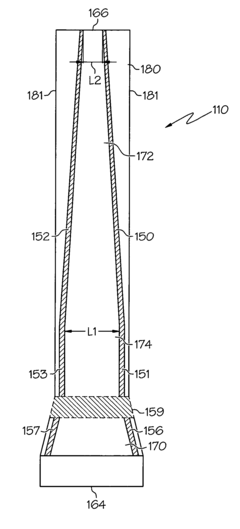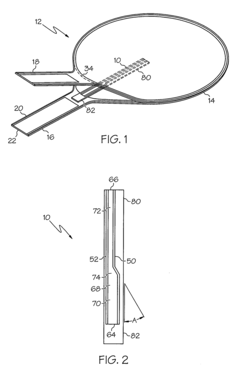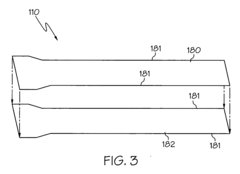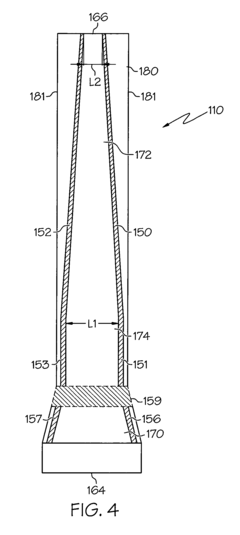Check Valves With Surface Modification For Reduced Friction
Technology Background And Goals
Particular emphasis will be placed on recognizing the major technical hurdles and limiting factors that currently impede progress in reducing friction through surface modification techniques for check valves. This analysis will shed light on the critical obstacles that must be overcome to achieve significant breakthroughs in this domain.
Check Valves Market Demand Analysis
- Growing Demand for Efficient Fluid Control
The market demand for check valves with reduced friction is driven by the need for efficient fluid control systems in various industries, such as oil and gas, chemical processing, and water treatment. - Energy Savings and Cost Reduction
Reduced friction in check valves can lead to significant energy savings and cost reductions in fluid handling systems, as it minimizes pressure losses and reduces the required pumping power. - Environmental Considerations
Lower energy consumption associated with reduced-friction check valves contributes to sustainability efforts and aligns with environmental regulations aimed at reducing carbon footprints. - Maintenance and Reliability
Surface-modified check valves with reduced friction can potentially extend equipment lifespan and reduce maintenance requirements, resulting in lower operational costs and improved system reliability. - Emerging Applications
The demand for reduced-friction check valves is expected to grow in emerging applications, such as renewable energy systems, desalination plants, and advanced manufacturing processes, where efficient fluid control is crucial.
Technology Status And Challenges
- Valve Design Evolution
Tracing the development of check valve designs, from traditional swing and lift types to advanced configurations like tilting disc and double-door valves, aimed at reducing friction and improving flow efficiency. - Material Advancements
Exploring the use of advanced materials, such as ceramics, polymers, and composites, to enhance valve durability, corrosion resistance, and friction reduction capabilities. - Surface Modification Techniques
Evaluating various surface modification methods, including coatings, texturing, and surface treatments, to create low-friction surfaces and improve valve performance. - Computational Fluid Dynamics (CFD) Analysis
Leveraging CFD simulations to optimize valve geometries, predict flow patterns, and identify potential areas of high friction or turbulence, guiding design improvements. - Challenges and Limitations
Addressing challenges such as material compatibility, manufacturing constraints, and operating conditions that may impact the effectiveness of surface modifications and friction reduction strategies.
Current Technical Solutions
01 Streamlined Valve Design
Various check valve designs aim to reduce friction and improve flow efficiency by incorporating features such as streamlined valve bodies, low-friction sealing surfaces, and optimized valve geometries to minimize turbulence and pressure drop.- Optimized Valve Design: Various check valve designs aim to reduce friction and improve flow efficiency by optimizing valve components, materials, or configurations to minimize resistance and turbulence during fluid flow.
- Surface Treatments: Surface treatments or coatings can be applied to check valve components to reduce friction and improve flow characteristics by modifying surface roughness, applying low-friction coatings, or incorporating lubricious materials.
- Valve Seat and Sealing Mechanisms: The design of valve seats and sealing mechanisms can play a crucial role in reducing friction and improving sealing performance by optimizing geometries, materials, and sealing configurations to minimize friction and wear while ensuring effective sealing.
- Actuation Mechanisms: The actuation mechanisms responsible for opening and closing check valves can be designed to reduce friction and improve operational efficiency by optimizing linkages, bearings, or other components involved in valve actuation.
- Low-Friction Materials and Coatings: The selection of low-friction materials, such as ceramics or polymers, or specialized coatings for check valve components can significantly impact friction levels, minimizing friction and wear.
02 Low-Friction Materials
The selection of low-friction materials, such as certain polymers or coatings, for check valve components like valve seats, discs, or sealing surfaces can reduce sticking and improve valve operation.Expand Specific Solutions03 Lubrication Techniques
Lubrication techniques, such as the use of lubricants, coatings, or self-lubricating materials on valve components, can be employed to reduce friction in check valves, facilitating smooth operation and minimizing wear.Expand Specific Solutions04 Wear-Resistant Design
Check valve designs can incorporate features to minimize wear and friction over extended use, such as the use of wear-resistant materials, optimized valve geometries, and mechanisms to prevent sticking or galling between moving parts.Expand Specific Solutions05 Friction Testing and Analysis
Methods and techniques for testing and analyzing friction in check valves, such as friction measurement, flow testing, or computational fluid dynamics (CFD) analysis, can be employed to evaluate performance and identify areas for improvement.Expand Specific Solutions
Check Valves Main Player Analysis
Honeywell International Technologies Ltd.
Cameron International Corp.
Key Technology Interpretation
- The check valve has a non-parallel set of heat seals forming the outlet portion, which focuses the flow of gas and reduces flapping and leakage.
- The outlet width is substantially less than the distance between the peripheral edges, which helps to control the flow and reduce leakage.
- The valve design allows for tying of balloons while reducing the risk of leaking, and enables faster inflation without leakage, reducing labor costs and faulty product returns.
Technology Economic Analysis
The economic analysis of technologies with surface modification for reduced friction in check valves involves understanding the potential cost savings and market opportunities associated with this innovation. Reduced friction in check valves can lead to increased efficiency, lower maintenance costs, and extended product lifespan.
The initial investment required for implementing surface modification technologies may be significant, as it involves research and development efforts, specialized equipment, and process optimization. However, the long-term benefits of reduced friction and associated cost savings could outweigh the upfront costs.
Reduced friction in check valves can result in lower energy consumption during operation, leading to cost savings on energy bills. Additionally, decreased wear and tear on the valve components can translate into fewer maintenance requirements and replacements, further reducing operational expenses.
From a market perspective, industries that rely heavily on check valves, such as oil and gas, chemical processing, and water treatment, may be interested in adopting surface modification technologies for improved efficiency and cost savings. The potential market size can be estimated based on the number of existing installations and projected growth in these industries.
Moreover, the environmental benefits of reduced friction, such as lower energy consumption and emissions, may align with sustainability initiatives and regulations, creating additional incentives for adoption. Businesses can leverage these benefits to enhance their environmental credentials and attract eco-conscious customers.
Overall, a comprehensive economic analysis should consider factors such as initial investment costs, projected operational cost savings, potential market size, competitive landscape, and potential regulatory or environmental incentives. By quantifying the economic advantages, businesses can make informed decisions regarding the implementation of surface modification technologies for reduced friction in check valves.
Check Valves Friction Reduction Strategies
Several surface modification techniques have been explored for check valves, including chemical treatments, physical vapor deposition (PVD), and surface texturing. Chemical treatments, such as electropolishing or passivation, can improve corrosion resistance and surface smoothness, reducing the likelihood of sticking or galling. PVD techniques, like diamond-like carbon (DLC) coatings, offer superior hardness and low friction coefficients, enhancing wear resistance and reducing adhesive wear.
Moreover, surface texturing techniques, such as laser surface texturing or mechanical machining, can introduce controlled surface patterns or features that promote hydrodynamic lubrication and reduce friction. These techniques can create microscopic reservoirs for lubricant retention or induce beneficial surface roughness patterns, leading to improved fluid flow characteristics and reduced frictional losses.
The implementation of surface modification techniques in check valves can yield numerous benefits, including extended service life, reduced maintenance requirements, improved energy efficiency, and enhanced overall system reliability. These benefits have the potential to translate into significant cost savings and environmental benefits across various industries.
Surface modification for reduced friction in check valves represents a promising research area with significant potential for innovation and industrial application. Ongoing research efforts focus on optimizing surface modification processes, exploring new materials and coatings, and developing advanced characterization techniques to better understand the underlying mechanisms governing friction reduction and performance enhancement.



